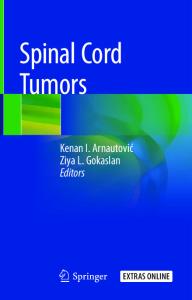Spinal magnetic resonance imaging with reduced specific absorption rate in patients harbouring a spinal cord stimulation
- PDF / 168,624 Bytes
- 6 Pages / 595.276 x 790.866 pts Page_size
- 34 Downloads / 279 Views
CLINICAL ARTICLE - SPINE
Spinal magnetic resonance imaging with reduced specific absorption rate in patients harbouring a spinal cord stimulation device - A single-centre prospective study analysing safety, tolerability and image quality Urs M. Mutter & David Bellut & François Porchet & Bernhard Schuknecht
Received: 6 June 2013 / Accepted: 12 September 2013 / Published online: 29 September 2013 # Springer-Verlag Wien 2013
Abstract Background Spinal cord stimulation (SCS) is an accepted treatment in patients with failed back surgery (FBS), complex regional pain syndrome (CRPS) and persistent radicular pain following surgery. In order to avoid patient hazards or device malfunction manufacturers advise to abstain from magnetic resonance imaging (MRI) in patients with implanted electrodes or pulse generators. Methods In a prospective study, 13 patients harbouring an implanted Medtronic Spinal Cord Stimulation (SCS) device underwent MRI (1.5 T) of the lumbar (n=13), the cervical (n=2) or the thoracic spine (n=1) following the development of new spinal symptoms. An adapted MRI protocol was used limiting the transmitted energy and specific absorption rate. Tolerability and safety were assessed by means of a standardized patient evaluation form documenting pain on a visual analogue scale (0–10), neurologic deficit, and discomfort during the scan. In addition, overall satisfaction with the examination procedure was rated on a Likert scale (1–5). Image quality was rated independently and blinded to the presence of a SCS device by the radiologist and the surgeon
as equivalent, superior or inferior compared to the standard spine MRI examination. Results None of the 13 patients investigated by the modified spinal MRI protocol experienced new neurological deficits, worsening of symptoms or a defect/malfunction of the implant device. Three patients (23.1 %) reported transient warm sensation in the location of the electrode and in one case intermittent slight tingling in the lower extremities. Overall satisfaction with the examination was 1.13±0.34 according to Likert scale (1–5). The image quality was rated - not statistically significant - slightly inferior to standard lumbar spine imaging (0.82±0.54) with a kappa value of 0.68 between the two investigators. MRI examinations detected relevant and new lesions in 9 (69.2 %) patients which affected treatment in 8 (61.5 %) individuals. Conclusion Using a protocol with a reduced specific energy absorption rate, spinal MRI examinations in patients with SCS can be considered safe. The current view that neurostimulators are a general contraindication to MR examinations has to be reconsidered in patients with new or progressive spinal symptoms.
Urs M. Mutter and David Bellut contributed equally
Keywords Spine . Spinal Cord Stimulation . SCS . MRI . Magnetic resonance imaging
U. M. Mutter Neuro- und Wirbelsäulenzentrum, Hirslanden Klinik St. Anna, Lucerne, Switzerland U. M. Mutter : D. Bellut : F. Porchet Spine Center, Schulthess Clinic, Zurich, Switzerland D. Bellut Department of Ne
Data Loading...











